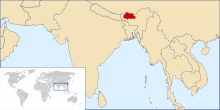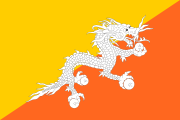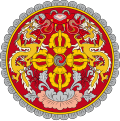
Bhutan's early history is steeped in mythology and remains obscure. Some of the structures provide evidence that the region has been settled as early as 2000 BC. According to a legend it was ruled by a Cooch-Behar king, Sangaldip, around the 7th century BC, but not much is known prior to the introduction of Tibetan Buddhism in the 9th century, when turmoil in Tibet forced many monks to flee to Bhutan. In the 12th century, the Drukpa Kagyupa school was established and remains the dominant form of Buddhism in Bhutan today. The country's political history is intimately tied to its religious history and relations among the various monastic schools and monasteries.

The national flag of Bhutan is one of the national symbols of Bhutan. The flag features a Chinese dragon from Bhutanese mythology. This alludes to the Dzongkha name of Bhutan – Druk Yul – as well as the Drukpa Lineage of Tibetan Buddhism, which is the dominant religion of Bhutan.

Jigme Dorji Wangchuck was the 3rd Druk Gyalpo of Bhutan.

Trashigang District is Bhutan's easternmost dzongkhag (district).
Articles related to Bhutan include:
The Kheng people are found primarily in the Zhemgang, Trongsa, Bumthang, Dagana, and Mongar Districts of central Bhutan. They speak the Kheng language, a member of the extended Sino-Tibetan language family belonging to the East Bodish languages group; it is mutually intelligible with the Bumthang language and Kurtöp language to the north. The Kheng people are ethnolinguistically same as the Bumthang people and Kurtöp people of central Bhutan and are more closely related to Ngalop people of western Bhutan than to their neighbors in eastern Bhutan, who are primarily Sharchops and speak Tshangla language. SIL International estimates there are 50,000 Kheng speakers as of 2009.

The Wangchuck dynasty have held the hereditary position of Druk Gyalpo of Bhutan since 1907. Prior to reunification, the Wangchuck family had governed the district of Trongsa as descendants of Dungkar Choji. They eventually overpowered other regional lords and earned the favour of the British Empire. After consolidating power, the 12th Penlop of Trongsa Gongsar Ugyen Wangchuck was elected Druk Gyalpo, thus founding the dynasty. The position of Druk Gyalpo – who heads the royal family of Bhutan – is more commonly known in English as the King of Bhutan, however "Druk Gyalpo" would be translated literally as "Dragon King"

Penlop is a Dzongkha term roughly translated as provincial governor. Bhutanese penlops, prior to unification, controlled certain districts of the country, but now hold no administrative office. Rather, penlops are now entirely subservient to the House of Wangchuck.

There are two dozen languages of Bhutan, all members of the Tibeto-Burman language family except for Nepali, which is an Indo-Aryan language, and Bhutanese Sign Language. Dzongkha, the national language, is the only native language of Bhutan with a literary tradition, though Lepcha and Nepali are literary languages in other countries. Other non-Bhutanese minority languages are also spoken along Bhutan's borders and among the primarily Nepali-speaking Lhotshampa community in South and East Bhutan. Chöke is the language of the traditional literature and learning of the Buddhist monastics.

The Penlop of Trongsa, also called Chhoetse Penlop, is a Dzongkha title meaning "Governor of the Province of Trongsa (Chhoetse)". It is now generally given to the heir apparent of the Kingdom of Bhutan, but historically was an important title, for the governor of Trongsa and the surrounding area, and was the route by which the House of Wangchuck came to the throne.
The Khengkha language, or Kheng, is an East Bodish language spoken by ~40,000 native speakers worldwide, in the Zhemgang, Trongsa, and Mongar districts of south–central Bhutan.
Bodish, named for the Tibetan ethnonym Bod, is a proposed grouping consisting of the Tibetic languages and associated Sino-Tibetan languages spoken in Tibet, North India, Nepal, Bhutan, and North Pakistan. It has not been demonstrated that all these languages form a clade, characterized by shared innovations, within Sino-Tibetan.
The East Bodish languages are a small group of non-Tibetic Bodish languages spoken in eastern Bhutan and adjacent areas of Tibet and India. They include:
Gongduk or Gongdu is an endangered Sino-Tibetan language spoken by about 1,000 people in a few inaccessible villages located near the Kuri Chhu river in the Gongdue Gewog of Mongar District in eastern Bhutan. The names of the villages are Bala, Dagsa, Damkhar, Pam, Pangthang, and Yangbari (Ethnologue).
The Dzala language, also called Dzalakha, Dzalamat, or Yangtsebikha, is an East Bodish language spoken in eastern Bhutan, in the Lhuntse and Trashiyangtse Districts.

Trongsa Province was one of the nine historical Provinces of Bhutan.

Bumthang Province was one of the nine historical Provinces of Bhutan.

Thimphu Province was one of the nine historical Provinces of Bhutan.

Kurmaed Province was one of the nine historical Provinces of Bhutan.















